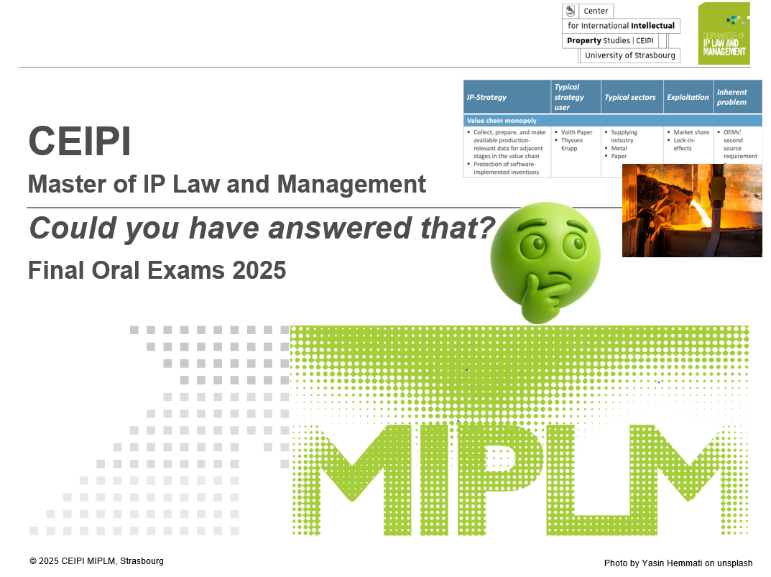Could You Have Answered That? Cracking the CEIPI MIPLM’25 Exam on IP Strategy — Task 20: Steelium and the Value Chain Monopoly
The Exam Task: Steelium
The CEIPI Master Program in IP Law and Management challenges its candidates with highly practical exam questions, each deeply rooted in real-life strategic IP decisions. One such challenge is Task 20, centered around Steelium, a fictional company in the steel and energy sector.
Task: Develop an IP strategy for Steelium to create a Value Chain Monopoly by locking-in partners and suppliers along the value chain. Consider the integration of IP into the business model and examine how lock-in effects can be achieved using patents and other IPRs.
The challenge asks candidates not just to recite theoretical knowledge but to design a strategic IP architecture that secures competitive advantages in a complex B2B ecosystem — a highly relevant skillset in today’s industrial economy.
What You Learn in the Lecture: Strategy Formulation and IP Lock-In
The Steelium case directly ties into the Strategy Formulation section of the CEIPI MIPLM Module 1, particularly under the themes of economic effect, appropriation, and impact. Let’s unpack the key insights:
1 . Value Chain Monopoly:
A value chain monopoly doesn’t mean owning the entire industry — it means occupying and protecting the most value-generating segments of the value chain. The lecture explains how IP can be used to:
- Control interfaces between different parts of the value chain
- Secure switching costs that bind partners to your solution
- License out selectively to reinforce your own standards
2 . Lock-In Effects:
Lock-in effects are mechanisms that increase dependency on your technology or business processes, making it costly or impossible for partners, customers, or suppliers to switch. From the lecture, several types of lock-in are discussed:
- Technological Lock-in: via patents on key functional modules or interfaces
- Organizational Lock-in: through platform-based ecosystems
- Contractual Lock-in: via license agreements with usage constraints
- Cognitive Lock-in: via brand familiarity or training investments
3 . IP as a Strategic Resource:
The Resource-Based View (RBV) teaches that sustainable advantages come from owning resources that are:
- Valuable
- Rare
- Inimitable
- Non-substitutable
IP rights, when aligned with a company’s capabilities and business model, check all four boxes — especially when embedded strategically into interfaces, dependencies, and value-creating activities.
IP Subject Matter Experts at the IP Business Academy
The Steelium case isn’t theoretical fiction — it reflects real-world industrial dynamics as discussed by leading IP experts on the IP Business Academy platform, including:
- Sascha Kamhuber: Patent Information in the Steel Industry
- Daniel Holzner: AI-assisted Invention Processes
- Bas Albers: IP Strategies for SME
- Sebastian Goebel: Streamlining Patent Drafting
These experts contribute insights via webinars, case studies, and teaching materials available to MIPLM students and SME learners globally.
Learners can find deep dives, articles, and even webinars on:
Sample Solution: Crafting an IP Strategy for Steelium
- Leveraging Road Mapping and Scenatio Thinking with Patent Insights
- Digitalization and Customization of Steel
- Patent Information Driving Steel Industry
- Deed Dive on IP Strategy
Let’s now simulate what a top-performing candidate might write in response to the Steelium case:
Company Profile: Steelium
Steelium is an integrated energy and materials company operating in the steel, infrastructure, and renewables value chains. Their core competencies lie in process engineering, advanced material composites, and industrial integration software.
Their goal: Create a value chain monopoly by locking in strategic partners — from raw materials to infrastructure applications.
Strategic Objectives
- Secure control over key value-adding interfaces (e.g., process modules, automation systems, control software)
- Embed IP in every layer of the industrial value chain, from supply to application
- Establish dependency through standardization and licensing structures
- Reduce churn and prevent substitution by creating switching costs
Value Chain Analysis
Steelium’s value chain includes:
1 . Raw Materials & Inputs
→ Lock-in via proprietary processing methods and materials handling IP
2 . Production Systems
→ Lock-in via patented automation controls and embedded software
3 . Energy Integration
→ Lock-in via IP on green hydrogen usage in steel manufacturing
4 . Customer Integration
→ Lock-in via IP-protected modules tailored to customers’ digital ecosystems
Lock-In Mechanisms
| Area | IP Tool | Lock-In Effect |
| Interface Technology | Patents | Force suppliers to conform to your system |
| Embedded Software | Copyright + Licensing | Update control, platform dependency |
| Manufacturing Process | Trade Secrets + Patents | Obscure reverse engineering, prevent replication |
| Product Design Standards | Design Rights + Licensing | Embed your design as industry default |
| Brand Reputation | Trademarks | Cognitive lock-in, reduce willingness to switch |
| Training & Support | Know-how Contracts | Organizational inertia, high switching costs |
Business Model Integration
Steelium doesn’t merely sell a product — they offer a platform-based solution. This model encourages ecosystem thinking:
- License out key modules to industrial customers — but only the standardized ones
- Keep custom modules as internal know-how or patent-protected trade secrets
- Use trademarks to distinguish Steelium-compatible components
- Control interfaces to keep customers on the Steelium ecosystem
This mirrors models used by successful industrial platform companies like Siemens (Xcelerator), Bosch, or ABB.
Appropriation and Economic Effect
By applying the CEIPI lecture model of IP Strategy Development, we identify:
- Economic Effect: Premium price for high-efficiency components and process modules
- Appropriation: Tight control over interfaces and platforms leads to sustained revenue
- Impact: Market share expansion through technological leadership
- Function: Use IP for protection, blockade, exchange, and incentivization
Steelium’s IP does not just protect their technology — it creates strategic dependency across the value chain.
Conclusion
In summary, Steelium’s IP strategy is built around two central strategic levers:
1 . Value Chain Monopoly: Owning and protecting the most profitable interfaces
2 . Lock-in Effects: Making switching so costly that customers and partners remain loyal
This strategy aligns perfectly with the strategic management principles covered in the CEIPI MIPLM lecture and reflects real industrial practices as documented by Subject Matter Experts on the IP Business Academy platform.
It’s a powerful reminder that in modern industry, intellectual property is not just a legal asset — it is a strategic weapon to shape markets, control interfaces, and anchor ecosystems.
For deeper insight, I recommend reading:
- IP Management Glossary Entry on Value Chain
- The Power of IP: How Intellectual Property Rights Shape Market Dynamics
- Strategic IP Management in Global Value Chains
These sources provide not only academic depth but also industry best practices that help transform theoretical answers into boardroom strategies.



